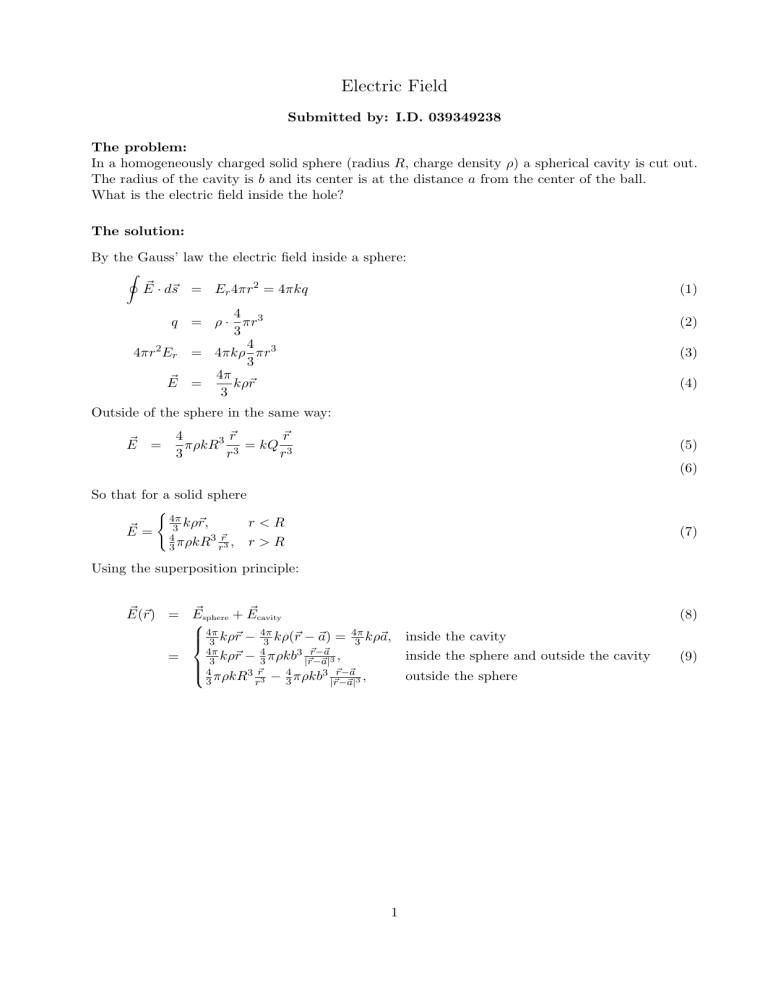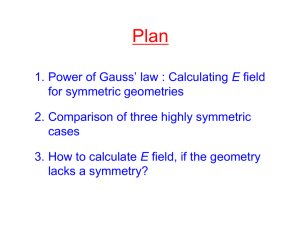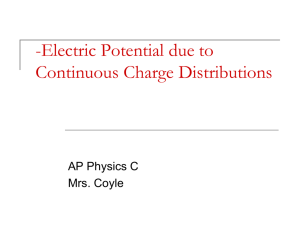Electric Field
advertisement

Electric Field Submitted by: I.D. 039349238 The problem: In a homogeneously charged solid sphere (radius R, charge density ρ) a spherical cavity is cut out. The radius of the cavity is b and its center is at the distance a from the center of the ball. What is the electric field inside the hole? The solution: By the Gauss’ law the electric field inside a sphere: I ~ · d~s = Er 4πr2 = 4πkq E 4 q = ρ · πr3 3 4 4πr2 Er = 4πkρ πr3 3 4π ~ = E kρ~r 3 (1) (2) (3) (4) Outside of the sphere in the same way: ~ = E 4 ~r ~r πρkR3 3 = kQ 3 3 r r (5) (6) So that for a solid sphere ( 4π r<R ~ = 3 kρ~r, E 4 ~ r 3 3 πρkR r 3 , r > R (7) Using the superposition principle: ~ r) = E ~ ~ cavity E(~ +E sphere 4π 4π 4π 3 kρ~r − 3 kρ(~r − ~a) = 3 kρ~a, inside the cavity −~a 4π r − 43 πρkb3 |~r~r−~ , inside the sphere and outside the cavity = 3 kρ~ a |3 4 πρkR3 ~r3 − 4 πρkb3 ~r−~a3 , outside the sphere 3 3 r |~ r −~a| 1 (8) (9) The electric field Submitted by: I.D. 313947202 The problem: An electrical infinite straight wire with charge density λ is at the center of an infinite hollow cylinder with charge density σ and a radius a. What is the electrical field everywhere? The solution: The solution is superposition of two fields: one from wire and another one from cylinder. Both fields we will find with the Gauss’ law. Because of symmetry,the field are in the radial direction only. Field of the wire: E · 2πrl = 4πkQ = 4πλl 2λk E = r (1) (2) Field of the cylinder: inside: E · 2πrl = 4πkQ = 4π0 (3) E = 0 (4) outside: E · 2πrl = 4πkQ = 4πk(2πal)σ 4πkaσ E = r (5) (6) The field from the whole system: ( 2λk r<R r r̂, ~ = E 4πaσ 2λk r r̂ + r r̂, r > R (7) 1 Gauss’s law - plane symmetry The problem: Find the electric field for: 1. infinite uniformly charged plane (charge density σ) 2. infinite uniformly charged layer (charge density ρ and width h) 3. two adjacent infinite layers of width h charged ρ+ and ρ− uniformly 4. two infinite planes perpendicular to each other, both charged σ uniformly. The solution: H R ~ · d~s = 4πk ρdv, and knowing that for plane symmetry E ~ = Ez ẑ 1. According to Gauss’ law E we construct a Gauss shell enclosing a piece of the plane of area S: I Z ~ · d~s = 4πk ρdv E (1) 2Ez · S = 4πkσS ~ z = 2πkσ · sign(z)ẑ E (2) (3) 2. For infinite layer of the width h (0 < z < h), if z > h or z < 0 the solution is identical to the one for the infinite plane. In the case 0 < z < h we construct a shell of area S symmetrical relatively to the middle of the layer - its its bottom plate is at z, the top plate is at h − z and the height, therefore, is h − 2z. 2E · S = 4πk(h − 2z)Sρ (4) E = 2πkρ(h − 2z) (5) z>h 2πkρh, = 2πkρ(2z − h), 0 < z < h −2πkρh, z<0 (6) Then Ez 3. Two infinite layers of thickness h charged ρ+ and ρ− uniformly. We choose the ρ+ charged layer to be at 0 < z < h and the ρ− charged layer to be at −h < z < 0. Then using the result of for the one layer and the superposition principle we obtain: 2πk(ρ+ + ρ− )h, z>h 2πkρ (2z − h) + 2πkρ h, 0<z<h + − Ez = (7) −2πkρ h + 2πkρ (h + 2z), −h < z < 0 + − −2πk(ρ + ρ )h, z < −h + − 4. Two infinite plains perpendicular to each other, both charged σ uniformly. By using the principle of superposition, we simply calculate the field intensity of each plane, and ~ = 2πkσ(sign(z)ẑ + sign(y)ŷ) (assuming that the plains in combine them. For two planes we get E question are the XY and XZ). 1




